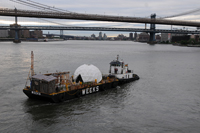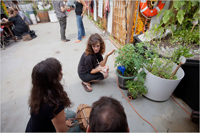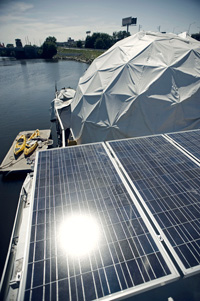MARCH 2011 MEETING AT THE MONMOUTH BEACH CULTURAL CENTER "WATERPOD"

The Waterpod was a 3,000-square-foot experimental platform for art and community living housing a varying team of four artists immersed in self sustained life. It was designed as an autonomous marine-based habitat and as an interactive public space of the future. The goals of the project were to illustrate solutions to rising sea levels and lack of land-based resources, to research and develop sustainable living systems, and to foster new forms of community-based gathering spaces.
Built atop a 99’ x 31’ industrial flat-deck barge, the Waterpod was constructed from donations and recyclables gathered from New York’s waste stream. It showcased a wide range of solutions-based technologies involving energy, agriculture, water treatment, nutrition, and marine navigation: its systems ran on solar power, and collected and treated waste and rain water, and its crew grew its own vegetables and took care of its egg laying chickens.
The Waterpod was the product of a multinational team of artists, designers, builders, civic activists, scientists, environmentalists, and marine engineers, brought together to propose a pathway to sustainable survival, mobility, and community building. It docked in all five of New York City’s boroughs, hosting close to 200,000 visitors on its voyage lasting from June through October 2009.


Mary Mattingly, the project’s founder, described the process of bringing the Waterpod to fruition; from community-wide collaborations, to navigating bureaucratic waters, to the living experiment that ensued, as well as the future of the project.
The project took the New York water front by storm and became an international sensation. The project also provided many lessons that can be implemented on the Navesink River.
